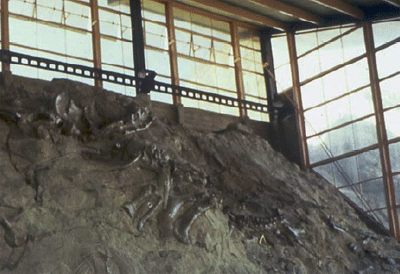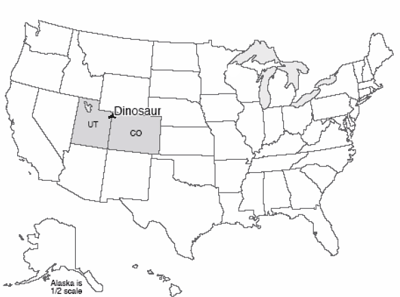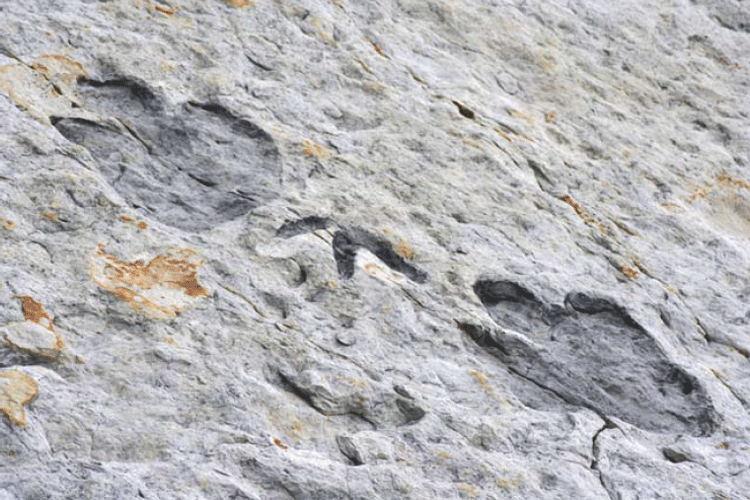Extinction and Dinosaur National Monument

Dinosaur National Monument lies in western Colorado and eastern Utah. The key rocks were deposited in swamps and and along rivers during the Jurassic in the middle of the Mesozoic, and are called the Morrison Formation. Before the modern Rockies were raised, sluggish streams flowed across the basins of this region, with numerous low, wet floodplains. Dinosaurs flourished. After some died, their bodies were washed up on sandbars, where their bones were buried before they were consumed by scavengers and gnawers. Over time, minerals carried in groundwater reacted chemically with the bone, depositing silica. (For a little more on petrification, see the Unit 11 Enrichment—no magic is involved!)
After the bone was turned to stone at what would become Dinosaur National Monument, the rocks of the region were raised and tilted during the mountain-building that formed the Rockies. Streams, including the Green River, cut through the rocks. The Canyon of Lodore on the Green is a favorite destination for serious white-water rafting. The first scientist in the region was John Wesley Powell, who went on to run the Grand Canyon. In 1909, workers from the Carnegie Museum of Pittsburgh found Dinosaur Ledge, a sandbar-turned-to-stone on which many dinosaur bones had been deposited and fossilized. Today, some of those petrified bones are on display in the Carnegie and in other great museums, but many of the bones have been left in the ledge to be viewed in the park (see the picture above).
What Killed the Dinosaurs?

The dinosaurs were the dominant large animals on Earth for over 100 million years. Many were quite small, but some were gigantic. They included large plant-eaters and large meat-eaters. Some spent at least part of their time flying or gliding, and others swam.
Mammals co-existed with the dinosaurs for most of the dinosaurs’ existence. However, almost all of the mammals remained small creatures—they generally could not outcompete the dinosaurs for the big-creature jobs.
Extinction is a normal process. A new species may arise and be more successful than an existing type, pushing the old type to extinction. Diseases, accidents, or other events may kill an entire population. And, extinction is forever. As populations vary owing to random factors, sometimes the population drops to zero. But when the population hits zero, the species can never come back up—you can’t just borrow a few creatures from a future generation and bring them back to fill in the gap. So all sorts of random events cause extinctions, and most of the species that have lived on Earth have become extinct. (This characteristic of extinction, that when you hit zero, you're gone, also applies to gamblers at casinos. To see why you’re likely to lose if you gamble, roll on back to the Unit 11 Enrichment.)
About 65 million years ago, at the end of the Cretaceous Period of the Mesozoic Era and the start of the Tertiary Period of the Cenozoic Era (the K/T boundary, because K is used for Cretaceous and T for Tertiary), all of the living dinosaurs died out suddenly. At the same time, many other types became extinct—more than half of the species known from fossils near the end of the Cretaceous became extinct at the end of the Cretaceous. Because survival of even a few individuals from a species can allow the species to persist, it is likely that almost all of the living things on the planet were killed. It was a catastrophic event, one of the most catastrophic in the history of the Earth.
The solution to this puzzle—how the dinosaurs and others were killed—was not found until fairly recently. At the K/T boundary, sedimentary rocks around much of the world contain a thin clay layer. This layer is rich in iridium, an element rare on Earth but common in meteorites. This clay layer contains bits of rock that were melted and refrozen rapidly to form glass, such as are produced by meteorite impacts. Quartz grains in the layer contain shock features, which are caused by very high pressures applied very rapidly, but by no other known mechanisms such as volcanic eruptions. The layer is rich in soot (black carbon) from fires. The layer is thicker in and near the Americas than elsewhere. Around the Caribbean, the layer includes a deposit of broken-up rock such as would be produced by a huge wave. And on the Yucatan Peninsula is a large crater, the Chicxulub Structure, that is dated to the K/T boundary. The crater is partially buried by younger rocks, but easily detected using geophysical techniques, drilling, etc. The crater is at least 110 miles (180 km) across, and perhaps as much as 180 miles (300 km) across.
This evidence indicates that a large meteorite, perhaps 6 miles (10 km) across, hit the Earth (the hole or crater made by an energetic projectile is usually a whole lot bigger than the projectile). Such a collision would have released more energy than all of the nuclear bombs that were on Earth when the U.S. and Soviet arsenals were at their largest.
Debate continues on exactly how such a meteorite would kill things, but it looks like fire and ice, and maybe acid. The impact would have blasted huge amounts of rock, from the meteorite and the Earth, into the stratosphere or above. As this rock fell back to Earth, friction with the air would have generated heat in the same way that a re-entering space capsule or a “shooting star” is heated. For a little while, the air would have been a toaster-broiler oven, cooking and burning everything beneath.
Following that, cold probably descended. The impact site included sulfur-containing rocks. The heat of the impact would have vaporized those rocks, and that vapor would have cooled later to form clouds in the stratosphere. The small particles of these clouds wouldn’t fall fast enough to heat up much; modern space capsules and meteorites fall fast enough to get hot, but raindrops and dust particles do not. But many, many small particles would block part of the sunlight and cool the Earth. We know that such cooling occurs with modern volcanic eruptions—big ones such as Mt. Pinatubo in 1992 cool the Earth by a degree or two for a year or two. A nuclear war might do much more, creating nuclear winter or at least nuclear fall. Even more of the sunlight would have been blocked after a huge meteorite impact, and the world may have frozen for a few years.
The sulfur particles, when they fell, would have made sulfuric acid, giving much stronger acid rain than the recent human-produced pollution. The incoming meteorite may have heated the surrounding air enough to burn the nitrogen in it, forming nitric acid that also would have produced acid rain.

The meteorite impact was not nearly big enough to roll the Earth over, notably move the orbit, rearrange the continents, or anything similarly cataclysmic for the physical behavior of the planet beyond the few years or decades of the heat, cold and acid, but the event was cataclysmic for life—almost all of the living things on Earth would have died. Who would have survived? Plants with long-lasting seeds, hibernators, things that live in ocean sediment or along spreading ridges, scavengers, probably some others with appropriate characteristics. The general pattern is that the surviving animals were small, and mammals did better than dinosaurs. (Although, yes, birds are a branch of the dinosaurs, and the birds are still with us.)
After the fire and ice were over, the “jobs” (ecological niches) of many of the dinosaurs were left open. There were no big plant eaters, or meat eaters, left. Over tens of millions of years, the mammals, freed of the competition from the dinosaurs, slowly came to take over the jobs of the dinosaurs. Some of the larger offspring of some species were successful, although most mammals remained small (mice, voles, etc.). Lining up the fossils over time, we see an evolutionary shrubbery—lots of branches, many extinctions where those branches were cut off, persistence of small creatures, but appearance of some large creatures, with those leading to modern lions and tigers and bears—and people. Biodiversity was hugely reduced by the meteorite, but over the next millions of years new species appeared a little more often than existing species went extinct, so that diversity increased back to more-or-less what it was before the meteorite, just with different species doing the jobs.
If today, Coke and Pepsi and all other soft-drink companies suddenly magically disappeared, new soft-drink companies would be started fairly soon, not because of a magical affinity for soft-drink companies, not because soft-drink companies must exist, but because we usually figure out how to take advantage of opportunities. In the same way, wiping out dinosaurs opened up a space for mammals.
More on Meteorites and Mass Extinctions.
Meteorite impacts have been happening throughout Earth history, and a Mars-sized body colliding with the Earth and blasting things into space is the best explanation for the formation of the moon. Big impacts were common early on. Evan Pugh Professor Jim Kasting of Penn State helped show that the heat from many of the early, huge impacts would have been enough to evaporate the whole ocean during the first few hundred million years of the planet, and that it was probably only about 3.8 billion years ago when the last impactor hit that was large enough to evaporate the sunlit upper layer of the ocean. Since then, collisions have been much smaller. The dinosaur-killer was larger than any that happened since, and than any for a long time before, but was not nearly big enough to evaporate much of the ocean.
There still are many large rocks out in space that go whizzing by the planet, and large impacts remain possible. One scientific estimate found that your chances of being killed by a meteorite impact are about the same as being killed in the crash of a commercial airliner. Commercial-airliner crashes kill a few hundred people per decade, and a meteorite might wait ten million years and then kill hundreds of millions of people, so the statistics are not exactly comparable, but the number is interesting. (In comparison, car crashes kill waaaaay more people, and far out-do tornadoes and hurricanes and earthquakes and food poisoning and bee stings and airliner crashes as killers of people in the developed world. In the short term, the most dangerous thing you do is probably driving a car. In the long term, smoking, over-eating, under-exercising, and other poor health habits are much more important.)
Scientists are coming up with ways to divert asteroids, and are looking for the asteroids, to help avoid such collisions. If we see an asteroid coming from far enough away, then we need to turn its path only a tiny bit to miss the Earth. One idea is to hit the asteroid with a bag of dust that would spread across one side, changing the reflectivity of the surface; the difference between reflecting and absorbing the sunlight would cause a tiny push that would steer the asteroid. Another idea is to send a spacecraft to sit next to the asteroid for a year; the tiny gravity of the spacecraft, tugging on the asteroid, would turn it a tiny bit. The fate of the dinosaurs has stimulated much of the interest in this, so some day we may be saved by paying attention to the big beasts of the past.
Meteorites are not the only ways to cause extinctions. A meteorite ended the Mesozoic age of dinosaurs and ushered in the Cenozoic age of mammals, but there doesn’t seem to have been a meteorite at the even bigger extinction that ended the Paleozoic age of shellfish and brought in the Mesozoic age of dinosaurs. The leading hypothesis for that extinction, still “hotly” debated, is that immense volcanic outpourings (the biggest known hot-spot head, if you remember far enough back to flood basalts and hot spots) over a million years or so released enough CO2 to make the climate really hot, and also produced easily weathered rocks that broke down and supplied fertilizer to the ocean. The warmer ocean held less oxygen because heating drives gases out of water; plants growing in the ocean released oxygen near the surface to go into the air just like always, but when these abundant plants died and sank into the low-oxygen deep layers of the ocean, decay used up the oxygen there and made "dead zones." The volcanic outpouring would have supplied sulfur as well, and with the oxygen gone that would have led to an ocean containing hydrogen sulfide, which causes the smell in rotten eggs and which is highly poisonous to most things, and some of that hydrogen sulfide would have escaped to the air. Special molecules from photosynthetic bacteria that use hydrogen sulfide are found from rocks of that age. We will discuss human-caused global warming next week, but don't panic, we do NOT expect it to cause the ocean to belch out deadly gases that kill most of the life on Earth!